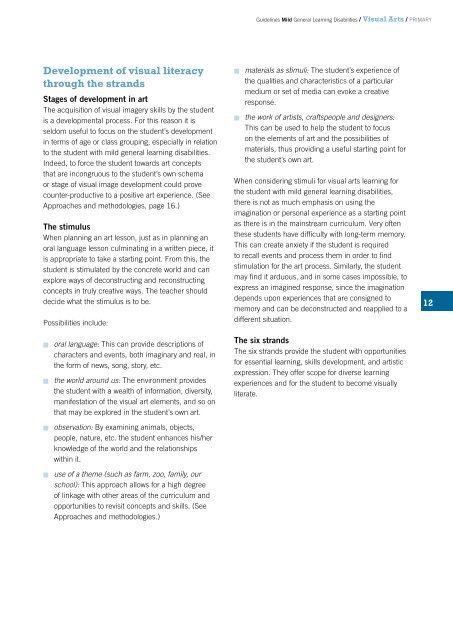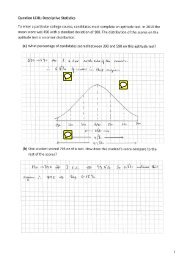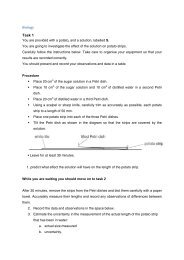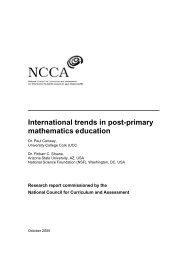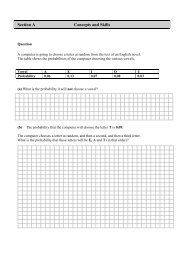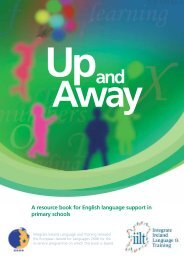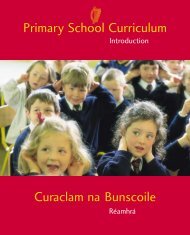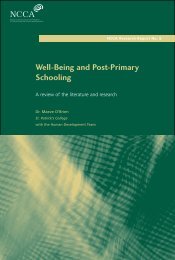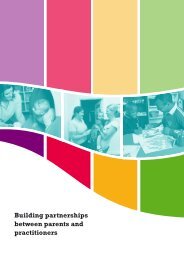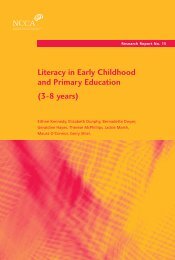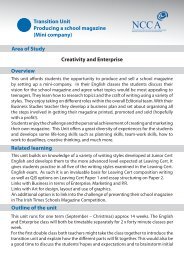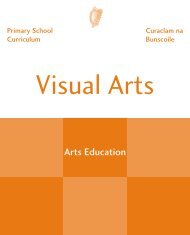Visual Arts - NCCA
Visual Arts - NCCA
Visual Arts - NCCA
Create successful ePaper yourself
Turn your PDF publications into a flip-book with our unique Google optimized e-Paper software.
Development of visual literacy<br />
through the strands<br />
Stages of development in art<br />
The acquisition of visual imagery skills by the student<br />
is a developmental process. For this reason it is<br />
seldom useful to focus on the student’s development<br />
in terms of age or class grouping, especially in relation<br />
to the student with mild general learning disabilities.<br />
Indeed, to force the student towards art concepts<br />
that are incongruous to the student’s own schema<br />
or stage of visual image development could prove<br />
counter-productive to a positive art experience. (See<br />
Approaches and methodologies, page 16.)<br />
The stimulus<br />
When planning an art lesson, just as in planning an<br />
oral language lesson culminating in a written piece, it<br />
is appropriate to take a starting point. From this, the<br />
student is stimulated by the concrete world and can<br />
explore ways of deconstructing and reconstructing<br />
concepts in truly creative ways. The teacher should<br />
decide what the stimulus is to be.<br />
Possibilities include:<br />
n<br />
n<br />
n<br />
n<br />
oral language: This can provide descriptions of<br />
characters and events, both imaginary and real, in<br />
the form of news, song, story, etc.<br />
the world around us: The environment provides<br />
the student with a wealth of information, diversity,<br />
manifestation of the visual art elements, and so on<br />
that may be explored in the student’s own art.<br />
observation: By examining animals, objects,<br />
people, nature, etc. the student enhances his/her<br />
knowledge of the world and the relationships<br />
within it.<br />
use of a theme (such as farm, zoo, family, our<br />
school): This approach allows for a high degree<br />
of linkage with other areas of the curriculum and<br />
opportunities to revisit concepts and skills. (See<br />
Approaches and methodologies.)<br />
n<br />
n<br />
Guidelines Mild General Learning Disabilities / <strong>Visual</strong> <strong>Arts</strong> / PRIMARY<br />
materials as stimuli: The student’s experience of<br />
the qualities and characteristics of a particular<br />
medium or set of media can evoke a creative<br />
response.<br />
the work of artists, craftspeople and designers:<br />
This can be used to help the student to focus<br />
on the elements of art and the possibilities of<br />
materials, thus providing a useful starting point for<br />
the student’s own art.<br />
When considering stimuli for visual arts learning for<br />
the student with mild general learning disabilities,<br />
there is not as much emphasis on using the<br />
imagination or personal experience as a starting point<br />
as there is in the mainstream curriculum. Very often<br />
these students have difficulty with long-term memory.<br />
This can create anxiety if the student is required<br />
to recall events and process them in order to find<br />
stimulation for the art process. Similarly, the student<br />
may find it arduous, and in some cases impossible, to<br />
express an imagined response, since the imagination<br />
depends upon experiences that are consigned to<br />
memory and can be deconstructed and reapplied to a<br />
different situation.<br />
The six strands<br />
The six strands provide the student with opportunities<br />
for essential learning, skills development, and artistic<br />
expression. They offer scope for diverse learning<br />
experiences and for the student to become visually<br />
literate.<br />
12


